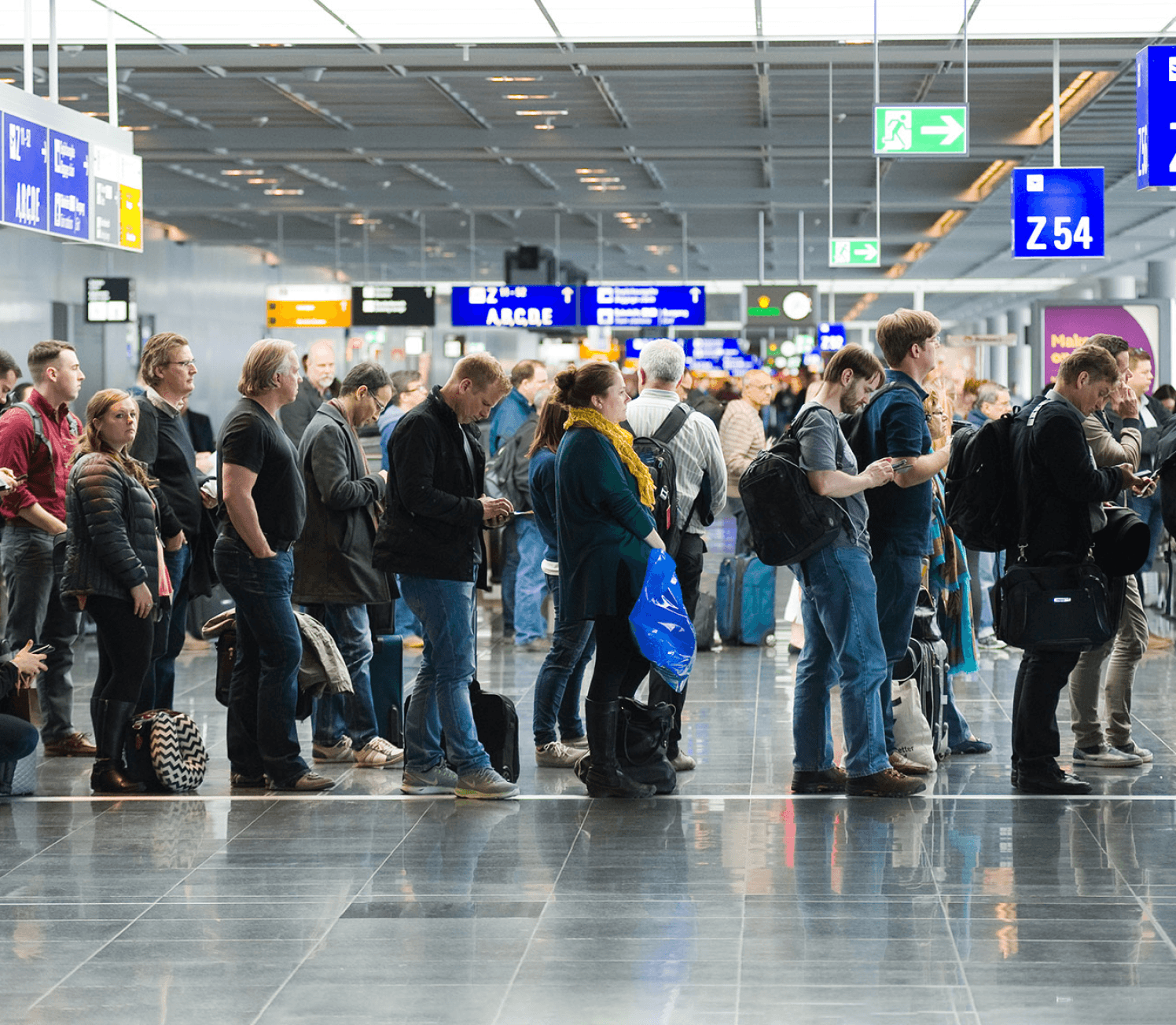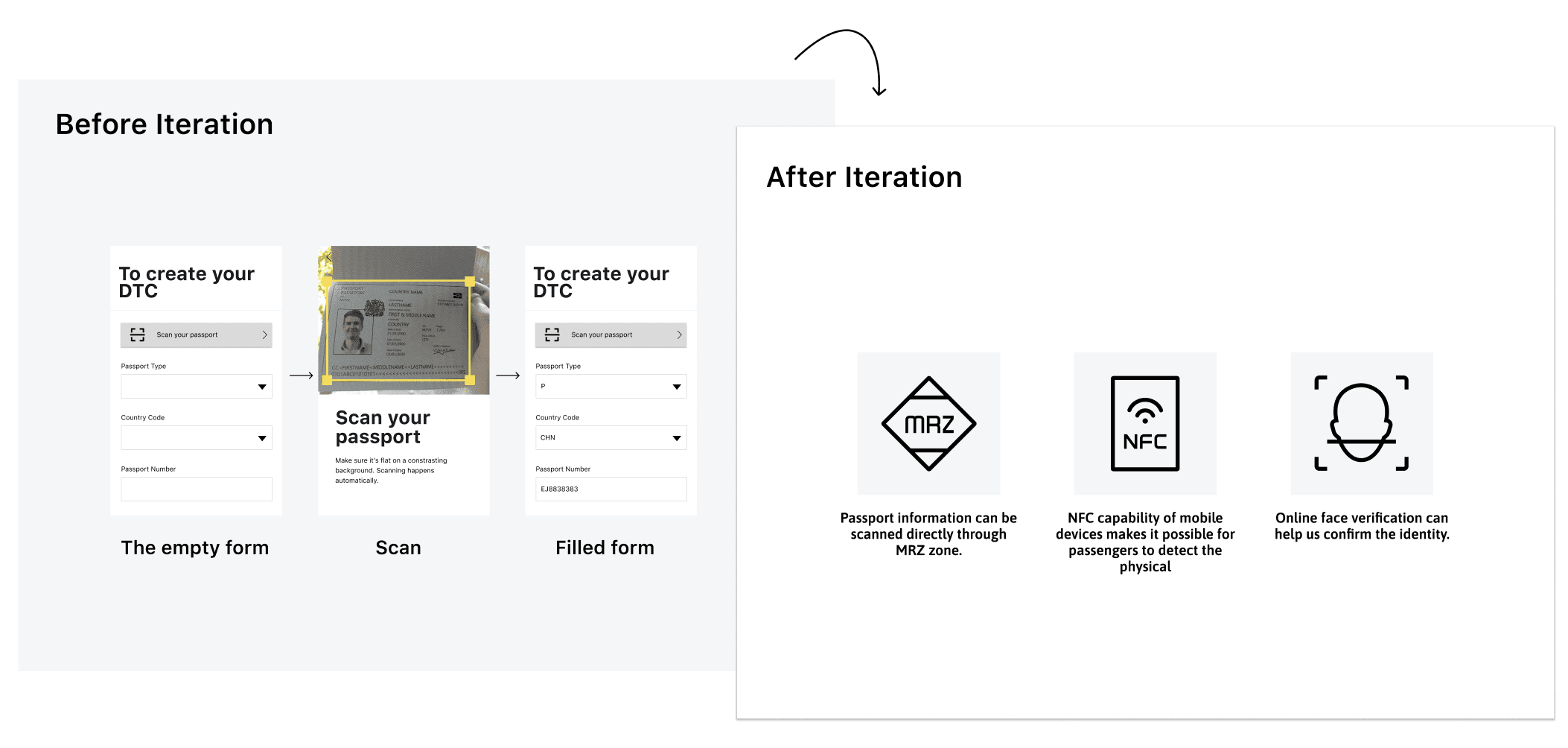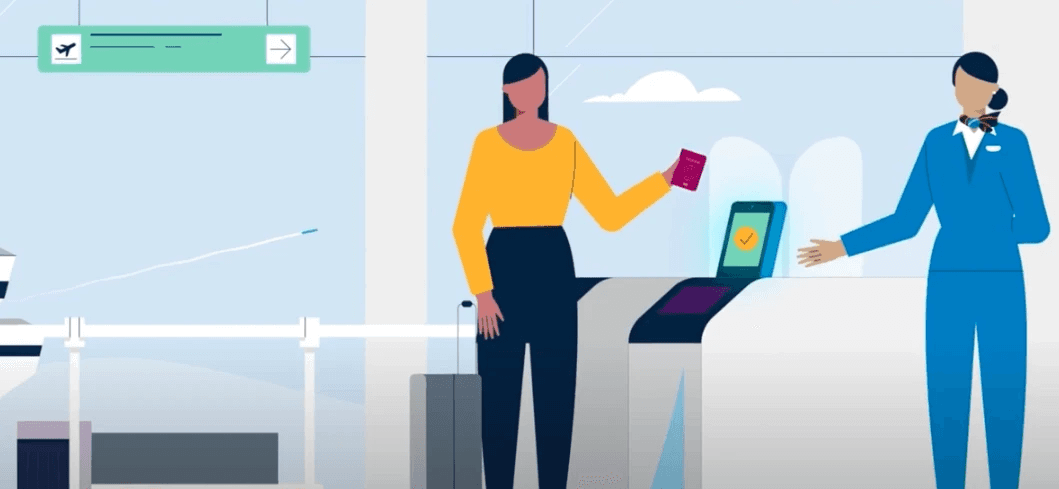Crafting the Future of Travel
In 2018, more than 57,000 travelers missed their flights due to outdated airport security protocols. This led to significant disruptions for airlines and immense frustration for passengers. The need for improved and more secure travel processes became glaringly apparent.
To address this issue, our team was tasked with rethinking the future of cross-border traveling experience and coming up with a revolutionary solution in this space.
My Role
As part of a two-member team, I spearheaded several critical aspects of the project. My responsibilities included helping conduct primary and secondary research, ideating and analyzing trends, and independently deliver the user interface design and interactive prototyping.
Duration
Jan 2024 - Apr 2024
The Travel landscape
By 2037, the International Air Transport Association (IATA) predicts that 8.2 billion air travelers will take to the skies annually. To handle this surge, governments and border control operators must implement efficient Entry/Exit solutions. This involves deploying near walk-through border processes to minimize waiting times and enhance the traveler experience.




Decode the problem
To truly understand the emotional journey of our potential customers, we created a storyboard that captured travelers’ daily challenges. This revealed three critical steps in the most time-consuming parts of the airport security process. These insights were visualized through sketches, providing a clear picture of the frustrations faced by travelers.

Evolutionary Design
Idemia has a range of premier security products, including MID for mobile identity, ID Way for identity management and sharing, IBRS for multi-modal biometric services (such as portrait and fingerprint recognition), and IPRS for storing proof of identity. These flagship products cater to millions of customers worldwide, ensuring their security needs are met with excellence.
Recognising the pressing need to address airport security concerns, we initiated a brainstorming session with our cross-functional team. Together, we explored how our suite of solutions could be leveraged to tackle the challenges faced in airport security.



Process Diagram and Overview

Research
We conducted extensive research to understand the current pain points in airport security. This involved synthesizing data from user interviews, surveys, and observations. Key findings highlighted that:
- Long waiting times were a major source of frustration.
- The manual checking process often led to errors and delays.
- There was a strong preference for digital solutions that could streamline the experience.
"Airport security is a nightmare! I spend more time in line for those checks than actually in the flight. It's beyond frustrating."
"The whole security process feels like a joke. I never thought I'd spend hours just waiting to get through a checkpoint. It's infuriating."
"There's got to be a better way to ensure safety without making travelers endure endless lines and waiting. The frustration is real."
"It's like they want us to arrive at the airport days in advance. The security checks take forever, and there's no end to the frustration."
"Security checks are the bane of my travel experience. It's like they actively try to make it as frustrating as possible. Something needs to change."
"The inefficiency of airport security is mind-boggling. I can't wrap my head around why it takes so long just to get through a checkpoint."

"I just want to get to my destination without feeling like I've run a gauntlet. The constant frustration with airport security is exhausting."
initial sketches
Before diving into digital tools, our team engaged in a full day of brainstorming. Each member presented different sketches for the same concept, which we then critiqued and merged into a unified wireframe. This iterative process ensured that we captured the best ideas and addressed potential issues early on.


Fill passport by scanning
Scan Visa
Airport waiting time
Face verification
Feedback with technology and legal teams
As we uncovered new constraints, both legal and technical, we would work through them in team discussion. Concessions had to be made around some areas in the flow, such as certain steps needing to be completed before others due to information dependencies.

Overcoming Challenges
Initial Ideas and Rejections:
Our initial designs focused on creating a seamless and intuitive user experience. We envisioned a simple app where users could scan their passports, verify their identity using biometric data, and then use their smartphones as a digital passport. However, our first round of designs faced significant pushback from both the legal and security teams.
Legal Concerns:
The legal team raised concerns about the storage and transmission of sensitive personal information. They highlighted strict regulations around data privacy and the potential for misuse of biometric data.
Security Issues:
The security team was wary of potential vulnerabilities in the system. They were concerned about ensuring the data remained secure, especially during transmission and storage, and the potential risks of hacking or identity theft.
Iterative Problem-Solving
To address these concerns, we held a series of collaborative workshops with the legal and security teams. These sessions were critical in understanding their perspectives and constraints. We adopted an iterative problem-solving approach:
Data Encryption: We implemented end-to-end encryption for all data transmissions. This ensured that user data remained secure from the moment it was captured until it was stored.
Local Storage with Secure Elements: Instead of storing sensitive information in the cloud, we decided to use the secure elements of the user's smartphone for local storage. This drastically reduced the risk of data breaches.
Compliance with Regulations: We worked closely with the legal team to ensure our solution complied with all relevant data protection regulations, including GDPR. This involved implementing strict access controls and user consent mechanisms.
User Education: We developed a comprehensive user education program to inform users about how their data would be used and stored securely. This helped build trust and addressed privacy concerns.
Concept iteration
As we uncovered new constraints, both legal and technical, we would work through them in team discussion. Concessions had to be made around some areas in the flow, such as certain steps needing to be completed before others due to information dependencies.

DTC App - onboarding flow on the go
t
The DTC App makes it possible to quickly generate your digital traveling passport.
The DTC App makes it possible to quickly generate your digital traveling passport.
The DTC App makes it possible to quickly generate your digital traveling passport.
The DTC App makes it possible to quickly generate your digital traveling passport.
Quickly scan the passport
Immediately tap passport
Get your DTC immediately
Enter identity by face verification
Scan the Passport MRZ
Back
MRZ are the lines of characters located at the bottom of your passport data page
Start scan
Tap Passport with NFC
Back
Close your passport and hold it at the back of the phone to read the chip using NFC
Start SCAN
Face Verification
Back
Verify your face by bring your phone in to eye level and place your face around the frame
continue
Wallet
Scan
Requests
More

Document ID
Passport NDL
Details
Document number
AX12345678
Active
Status

Hi Lilian
Your DTC is here
share
DTC App - SCAN THE code at the airport
The DTC App makes it possible to quickly generate your digital traveling passport.
Wallet
Scan
Requests
More
Scanning for the QR code
Scan


DTC App - Prototype
The DTC App makes it possible to quickly generate your digital traveling passport.
conclusion
The development of the Digital Travel Credential represents a significant step forward in modernizing airport security and improving the travel experience. By embracing innovation and addressing key pain points, we have crafted a solution that not only meets the needs of today's travelers but also prepares for the future demands of the aviation industry.